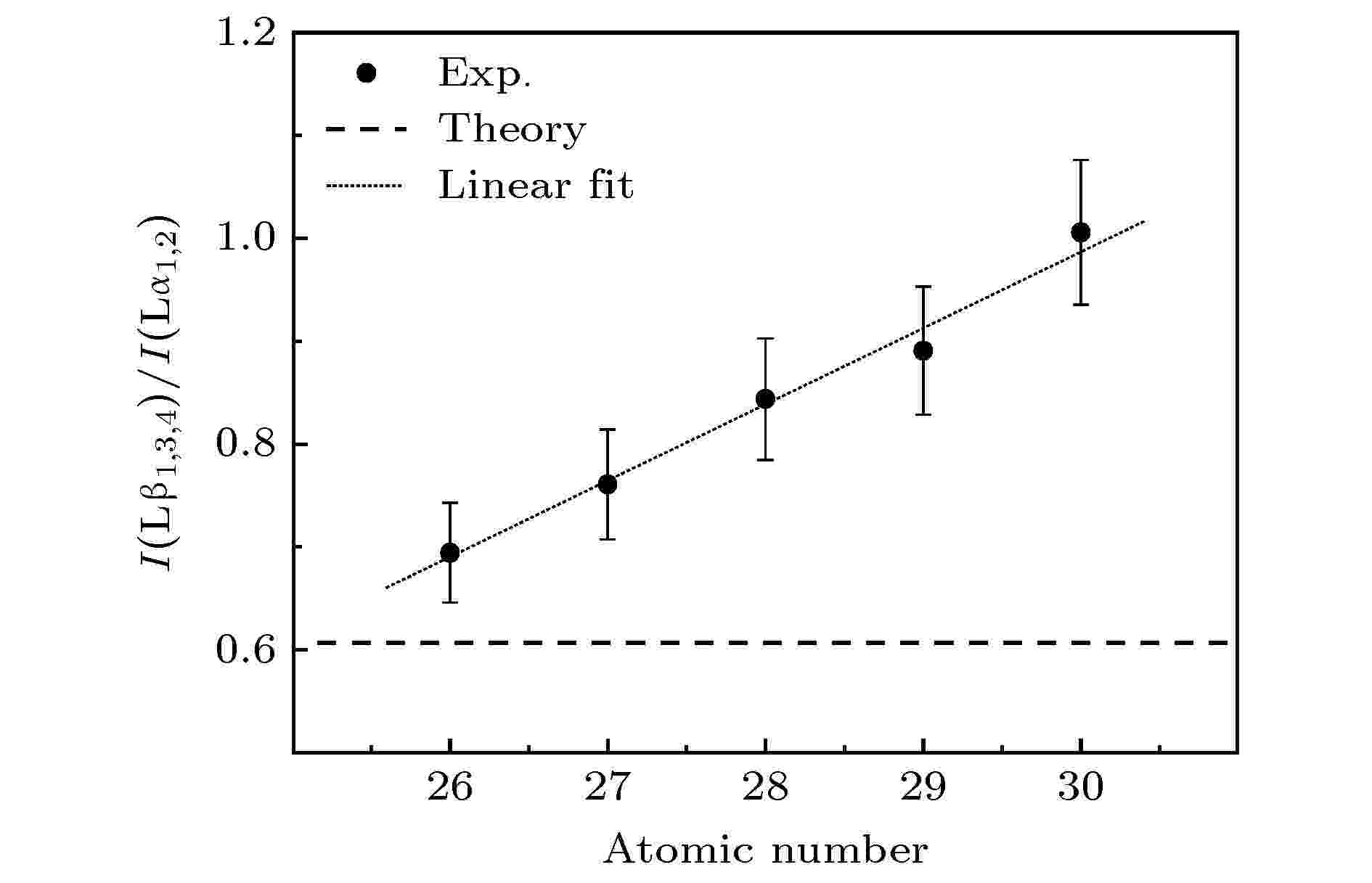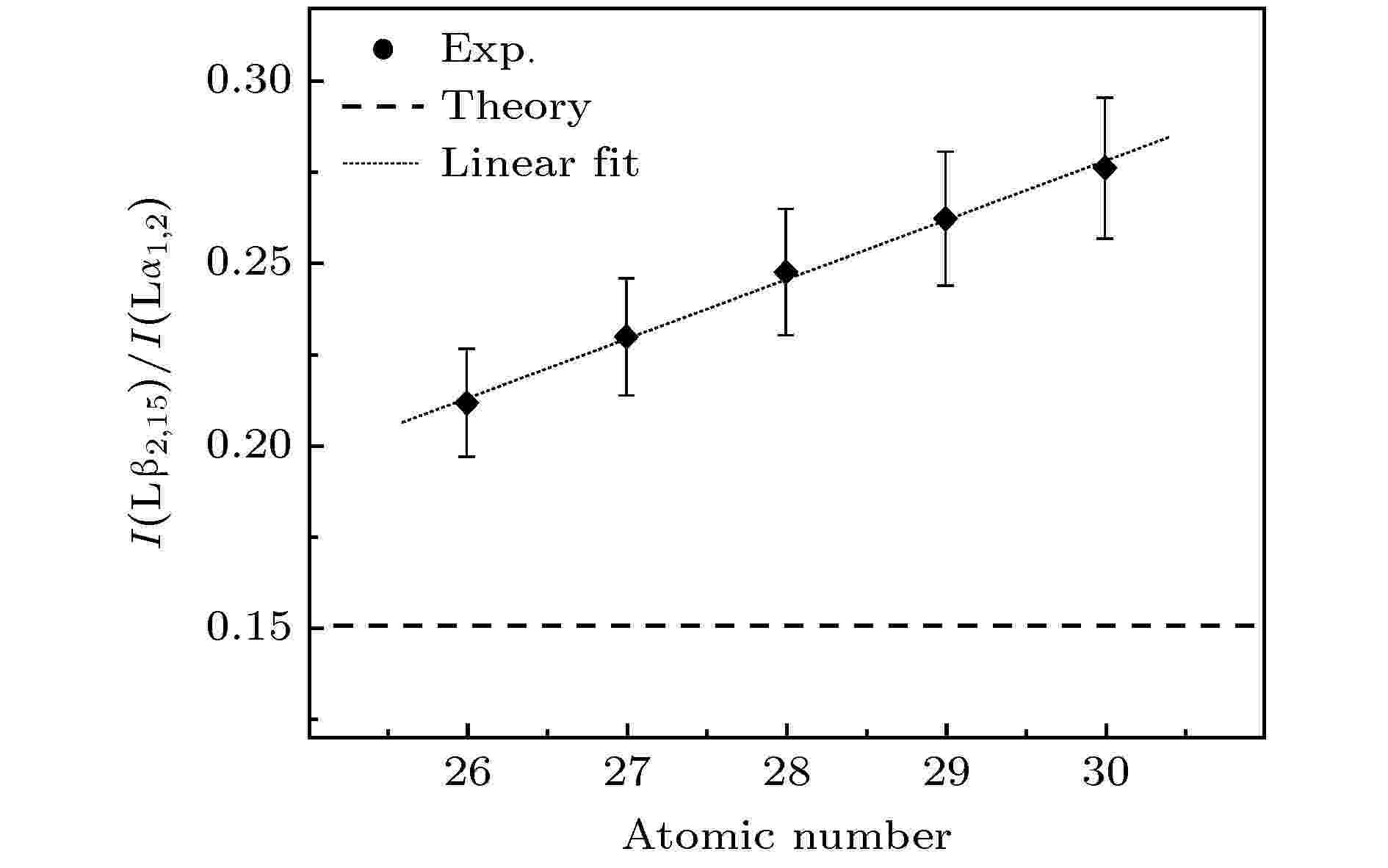全文HTML
--> --> -->高电荷态离子激发内壳层过程的以往研究大体可以归为两类, 一类是在低于玻尔速度的低能区, 实验上, 以Briand等[16-18]的研究为例, 利用晶体谱仪, 通过对K壳层X射线的精细结构分析, 阐述了靶材表面附近空心原子的形成机制; 理论上, Burgd?rfer等[19]建立了经典过垒模型对这一过程进行描述. 另一类是集中在能量为几十到百MeV的中高能区, 通过X射线发射截面的实验测量和理论分析, 研究了内壳层的电离问题, 并发展了成熟的模型对其进行估算, 例如, 两体碰撞近似(binary encounter approximation, BEA)、平面波玻恩近似(plane-wave Born approximation, PWBA)和基于PWBA修正的ECPSSR(energy-loss, Coulomb-deflection, perturbed-stationary-state relativistic)理论[20-22]. 然而, 在玻尔速度附近能区, 由于受到实验条件的限制, 实验上的研究相对较少, 理论上该如何描述, 也暂无定论.
不同于低速离子在靶材上下表面形成第一、二代空心原子的中性化退激, 近玻尔速度高电荷态离子碰撞产生的内壳层过程具有其独特性, 除了电子俘获的中性化过程外, 它还具有足够的能量, 进入靶材与靶原子发生近距离的碰撞, 产生库仑电离, 伴随内壳层空穴的退激, 外壳层可能处于多电离的状态. 这使得相应X射线发生频移、展宽以及分支比的变化. S?abkowska和Polasik[23]以及Czarnota等[24]利用特征谱卫星线结构研究了靶原子多电离的现象, Clark等[25]和Zhao等[26]通过谱型分析阐述了高电荷态Xeq+离子在靶材上表面的退激问题. 本文将重点讨论近玻尔速度高电荷态离子在下表面的中性化和外壳层多电离过程.
实验利用速度为1.2v0 (v0 = 2.19 × 106 m/s, 玻尔速度)的I20+离子轰击Z2 = 26—30 (Z2表示靶原子序数)的不同固体厚靶, 测量I的L壳层分支X射线辐射. 分析特征谱线的辐射过程和能量移动, 各分支谱线的相对强度比随靶原子序数的变化. 讨论近玻尔速度炮弹离子多电离态的形成以及其对X射线辐射的影响.
3.1.I的L壳层X射线辐射谱
图1给出了作用于不同靶材表面时, 4.5 MeV I20+离子激发的特征X射线谱. 利用Origin多峰拟合程序进行Gauss拟合分析, 实验谱线完全符合高斯线型, 不同靶面上的谱具有相似的结构, 由6条分辨较好的谱线组成. 由能量识别可知, 这是I的L壳层分支X射线, 可标记为Lι, Lα1, 2, Lβ1, 3, 4, Lβ2, 15, Lγ1和Lγ2, 3, 4, 4' X射线, 如图2所示, 分别对应的能级跃迁为: M1–L3, M5, 4–L3, M4–L2/ M3, 2–L1, N5, 4–L3, N4–L2和N3, 2–L1/O3, 2–L1[27]. 图 1 4.5 MeV I20+离子作用于不同靶材激发的L壳层X射线. 虚线为各分支谱线的拟合, 实线为总的实验谱线的拟合结果
图 1 4.5 MeV I20+离子作用于不同靶材激发的L壳层X射线. 虚线为各分支谱线的拟合, 实线为总的实验谱线的拟合结果Figure1. I L-shell X-ray induced by 4.5 MeV I20+ ions impacting on various targets. The dotted line is the fitted results of sub-shell X ray. Line is the fitted results of the total experiment spectra.
 图 2 L壳层分支X射线跃迁图
图 2 L壳层分支X射线跃迁图Figure2. Transitions of L-subshell X-rays.
离子源到实验靶室中心的距离约为12.7 m, 4.5 MeV I离子的速度约为2.61 × 106 m/s, 考虑到加速之前的运行, I离子从离子源飞行到靶面所需要的时间要大于4.87 × 10–6 s, 这足够让所有亚稳态的I20+离子到达靶面之前都退激到基态, 所以可以断定, 实验谱线并非源于亚稳态离子的退激. I20+离子的基态剩余电子排布为[Ar]3d104s24p3, L壳层是满电子排布的, 所以, 实验谱线也不是上表面第一代空心原子的退激结果. L壳层X射线的辐射需要相应的空穴和上能级电子, 实验谱线的出现表明入射离子在下表面与靶原子的作用发生了碰撞电离, 同时也俘获靶中的电子, 形成了第二代的空心原子. 实验中I的L壳层分支X射线主要来自于下表面第二代空心原子的退激.
2
3.2.I的多电离
表1列出了轰击在不同靶面上时, I离子激发自身L壳层6条分支X射线的能量测量值, 作为对比, 同时给出了单电离的原子数据. 可以看出, 在实验测量误差范围内, 随着靶原子序数的增大, 各谱线的实验值基本为一常数, 没有明显规律性的变化, 但都大于单电离数据[28], Lι, Lα1, 2, Lβ1, 3, 4, Lβ2, 15, Lγ1, Lγ2, 3, 4, 4' X射线分别向着高能方向移动了45, 31, 68, 124, 100和133 eV. 根据3.1节的讨论, 炮弹离子L X射线的辐射发生在下表面的碰撞之后, 入射离子虽然具有很大的初速度, 但是由于碰撞能量损失, 此时已经被减速慢化, 多普勒效应引起的频移可以忽略. 实验频移主要是由M, N, O等外壳层的多电离态引起的.| Lι/eV ± 3 eV | Lα1, 2/eV ± 3 eV | Lβ1, 3, 4/eV ± 5 eV | Lβ2, 15/eV ± 5 eV | Lγ1/eV ± 7 eV | Lγ2, 3, 4, 4' /eV ± 9 eV | |
| Atomic[28] | 3485 | 3937 | 4227 | 4508 | 4802 | 5065 |
| Fe | 3532 | 3966 | 4293 | 4631 | 4898 | 5192 |
| Co | 3529 | 3968 | 4293 | 4630 | 4904 | 5196 |
| Ni | 3532 | 3967 | 4292 | 4627 | 4896 | 5196 |
| Cu | 3529 | 3968 | 4297 | 4631 | 4909 | 5200 |
| Zn | 3529 | 3969 | 4299 | 4639 | 4907 | 5207 |
| Average | 3530 | 3968 | 4295 | 4632 | 4902 | 5198 |
表14.5 MeV I20+离子作用于不同靶材产生I的L壳层分支X射线能量, 作为对比, 第一行给出了单电离的原子数据, 实验误差主要来源于谱线的拟合误差
Table1.The energies of I L-subshell X-ray produced by 4.5 MeV I20+ ions impacting on various targets.
在高电荷态重离子与固体相互作用过程中, 源于碰撞电离和电子转移的作用, 除了单个内壳层电子的电离, 可能出现外壳层被多电离的情况. 由于多电离引起外壳层多空穴的出现, 减弱了原子核的屏蔽效应, 剩余电子的束缚能变大, 导致相应X射线辐射能的增加. 例如, I原子M5L3的跃迁能为3939 eV, 而I20+离子基态的相应跃迁能为3968 eV[29,30], 比原子态数据增加了29 eV. 本文中, I20+离子与靶原子的相互作用, 除了库仑碰撞产生L壳层的空穴以外, 在电离和俘获的协同作用下, M, N, O等壳层形成了区别于初始电子排布的多电离状态.
根据PWBA理论估算, 4.5 MeV I离子轰击本实验靶材产生自身L壳层的电离截面在1 b (1 b = 10–28 m2)量级, M壳层的电离截面在105 b量级, 并随靶原子序数的增加而增大. 若不考虑电子关联作用, 多电离的截面可写成多个单电离截面乘积的形式, 多电离度与单电离成正比关系. 所以, 本文I离子碰撞作用后的外壳层多电离度随靶原子序数的增加而增大, 这也可由下文中讨论的分支相对强度比的变化明显看出. 但是, 由于探测器分辨率的限制, 实验中没有观察到各谱线频移量随靶原子序数的明显变化.
2
3.3.多电离对分支X射线相对强度比的影响
外壳层的多电离不仅引起内壳层X射线辐射能的蓝移, 也会影响各分支谱线的跃迁几率, 导致观察谱线相对强度比的变化. 如图1所示, 利用Lα1, 2 X射线的计数对谱线进行了归一, 可以明显看到, 不同靶面上, 虽然各谱线的形状类似, 但是分支强度比发生了变化. 随着靶原子序数的增加, Lβ1, 3, 4的相对强度是逐渐增大的. 为进一步定量分析, 图3—图6给出了I的L壳层不同分支X射线相对强度比与靶原子序数的关系, 实验误差主要来源于X射线的计数统计, 最大约为10%. 可以看出, 实验值均大于单电离的理论计算, 并与Z2成正比, 这可以从炮弹离子的多电离态方面来进行理解. 图 3 I的Lβ1, 3, 4与Lα1, 2 X射线相对强度比随靶原子序数的变化
图 3 I的Lβ1, 3, 4与Lα1, 2 X射线相对强度比随靶原子序数的变化Figure3. Relative intensity ratios of I Lβ1, 3, 4 and Lα1, 2 x-ray as a function of target atomic number.
 图 6 I的Lγ2, 3, 4, 4' 与Lγ1X射线相对强度比随靶原子序数的变化
图 6 I的Lγ2, 3, 4, 4' 与Lγ1X射线相对强度比随靶原子序数的变化Figure6. Relative intensity ratios of I Lγ2, 3, 4, 4' and Lγ1 X-ray as a function of target atomic number.
Lβ1, 3, 4 X射线实际上包含退激到L2和L1支壳层的3条辐射谱线. 对于碘, M4–L2 (对应Lβ1 X射线) 与M3, 2–L1 (Lβ3, 4) 辐射跃迁的相对强度比约为10∶1[29,30]. Lβ1和Lα1, 2可以看作3d电子到不同下能级L2和L3的跃迁, 相应的辐射跃迁几率为0.038和0.021. L2, L3支壳层的俄歇退激率为0.767和0.921, 这都在同一数量级且没有太大差别[29,30]. 当外壳层M, N等处于多电离态时, L2, L3的俄歇退激将基本同幅度地减小, 从而引起M4–L2, M5, 4–L3辐射跃迁的荧光产额几乎同幅度增加, 这不会引起Lβ1和Lα1, 2 X射线分支强度比的明显变化. 但是, 相对于L3壳层, L2空穴的退激, 除了辐射跃迁和俄歇退激外, 增加了一个以激发N, O电子为主的L2–L3Y CK跃迁通道. 由于多电离的外壳层电子缺失, 部分CK过程被抑制, 相应的Lβ1 X射线发射将增强. 另外, M3, 2–L1跃迁下能级空穴的退激存在X射线辐射、俄歇跃迁和CK跃迁三个通道, 外壳层的多电离将削弱相应的无辐射跃迁过程, 从而使得Lβ3, 4 X射线辐射增强. 以上综合的结果导致Lβ1, 3, 4和Lα X射线的相对强度比增大. 随着Z2的增加, I离子外壳层的多电离度增大, Lβ1, 3, 4 X射线的增强幅度变大, 其与Lα1, 2的强度比增加, 如图3所示.
如图2, Lβ2, 15和Lα1, 2 X射线分别来自N, M轨道电子向同一下能级空穴L3的跃迁. 当M, N等壳层出现多电子缺失时, 空穴L3的俄歇退激被抑制, 相应的X射线发射增强. I的L3支壳层上俄歇跃迁几率a3比各分支X射线荧光产额ω3约大2— 3个数量级[29,30], a3的减小将引起ω3的大幅增加, 相应的X射线辐射明显增强. M5, 4–L3辐射跃迁的几率约为N5, 4–L3跃迁的6倍, Lβ2, 15 X射线的荧光产额更容易受到多电离的影响, 导致β2, 15与Lα1, 2 X射线的相对强度比大于原子数据. 随着靶原子序数的增大, 入射离子的多电离度增大, Lβ2, 15 X射线的荧光产额的增加幅度更大, 实验上观测到I(Lβ2, 15)与I(Lα1, 2)的比值增大, 如图4所示.
 图 4 I的Lβ2, 15与Lα1, 2 X射线相对强度比随靶原子序数的变化
图 4 I的Lβ2, 15与Lα1, 2 X射线相对强度比随靶原子序数的变化Figure4. Relative intensity ratios of I Lβ2, 15 and Lα1, 2 X-ray as a function of target atomic number.
同理, Lι X射线对应M1–L3辐射跃迁的几率约为Lα1, 2辐射几率的1/30[29,30], 所以, 由于外壳层的多电离引起的Lι X射线的辐射增强要大于Lα1, 2的增强, 如图5所示, Lι与Lα1, 2 X射线相对强度比大于单电离的理论数据, 并随靶原子序数的增加而增大.
 图 5 I的Lι与Lα1, 2 X射线相对强度比随靶原子序数的变化
图 5 I的Lι与Lα1, 2 X射线相对强度比随靶原子序数的变化Figure5. Relative intensity ratios of I Lι and Lα1, 2 X-ray as a function of target atomic number.
理论上单电离原子N5, 4–L3辐射跃迁的几率大约是M1–L3跃迁的5倍[29,30]. 由图4和图5分析可知, I(Lβ2, 15)与I(Lα1, 2)比值的实验结果比理论值约在1.4 —1.8倍, I(Lι)/I(Lα1, 2)的实验值是理论值的2— 3倍, 相比于原子数据, Lι X射线的增强幅度要大于 Lβ2, 15的增幅. 这一进步说明跃迁几率越小的X射线辐射过程, 荧光产额的改变受到外壳层多电离的影响越大, 相应辐射增强的幅度就越大.
图6给出了Lγ2, 3, 4, 4' 与Lγ1 X射线相对强度比, 可以看出, 实验测量值大于单电离的理论计算值, 并且, 随着靶原子序数的增加, 实验与理论之间的差值越来越大. 这可以类比图3中Lβ1 和Lα1, 2 X射线相对强度比的结果来理解. Lγ1 X射线对应N4–L2辐射跃迁, Lγ2, 3, 4, 4' 包含N3/N2/O3/O2到L1的4条辐射跃迁谱线. 这两组跃迁对应辐射跃迁的荧光产额分别为0.0028和0.0004, 相应下能级L2, L1上的俄歇跃迁几率a1, a2分别为0.767和0.495, 俄歇跃迁几率约为辐射跃迁几率的102—103倍[29,30], 多电离将对辐射跃迁产生明显的增强效应. Lγ2, 3, 4, 4' X射线的荧光产额比Lγ1的要小约1个量级, 更容易受到多电离的影响, 导致I(Lγ2, 3, 4, 4' )与I(Lγ1)比值的增大. 另外, L1空穴比L2多了一条L1–L2Y的CK跃迁通道, 这也会引起外壳层多电离时L1空穴辐射退激荧光产额的增大. 综合以上两点, 当外壳层发生多电离时, Lγ2, 3, 4, 4' X射线的荧光产额比Lγ1出现更大的增幅, 结果使得实验上I(Lγ2, 3, 4, 4' )/I(Lγ1)大于理论值.
感谢320 kV高电荷态离子综合实验研究平台工作人员对实验的技术支持和帮助.
